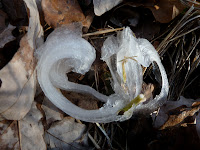 |
| Goldenrod Gall click to enlarge |
While spraying Sericea lespedeza on La Petite Gemme Prairie outside of Bolivar, we noticed a profusion of round green knobs in the middle of the long goldenrod stalks. The plants seemed otherwise healthy. This was a phenomenon crying out for a Google search.
 |
| Goldenrod gall fly |
The Goldenrod Gall is caused, logically enough, by the Goldenrod Gall Fly, Eurosta solidaginis. These tiny flies, a fifth of an inch long, essentially live and die on goldenrod. They are weak fliers, preferring to walk up and down the stem. When the male spots a female he gives her his version of a sexy wiggle and if she likes it, they mate. She then goes off to inject her eggs into the stem of a goldenrod.
The fly is completely dependent on goldenrod, its only host plant. Once the larvae hatch they eat the inside of the stem, their saliva stimulating the plant to produce the tough gall covering. The larva will dig an escape tunnel for future use and produce a type of antifreeze to survive the winter. In the spring the larva pupates and the adult emerges from its prefab tunnel.
 |
| Eurytoma wasp Bucknell.edu |
Now it starts to get interesting. There are two species of parasitic wasp (Eurytoma) whose larva can only survive by eating Goldenrod Gall Fly larva! The wasp insert their eggs into the gall and their larva then seek out the fly larva.
There is another gall forming insect with its own obligate larval predators. The Goldenrod Gall moth, Epiblema scudderiana, lives inside the hollow stem and creates a more subtle gall. It has larval predators that have not been identified.
This obligate interdependence occurs throughout the natural world. Loss of one species leads to extinction of many others that can't survive without it. Many people would like to see goldenrod disappear because they falsely blame if for their allergies.* If this were to occur, we would lose at least five insect species.
* Goldenrod is innocent of all charges in creating allergies- its pollen is only carried by insects. It blooms at the same time as its neighbor ragweed, whose tiny airborne pollen particles cause our allergies.
The whole story of these insect's life cycles with photographs can be found at this site.


















